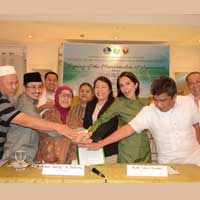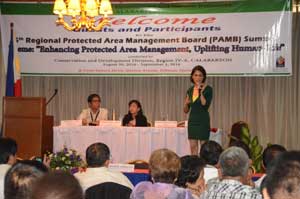DENR GIVES 20 MINING FIRMS SEVEN DAYS TO RESPOND TO MINING AUDIT FINDINGS
The Department of Environment and Natural Resources (DENR) has given 20 mining firms seven days to respond why their operations should not be suspended as recommended following the mining audit conducted nationwide.
DENR Secretary Regina Paz Lopez said that the mining audit was completed in August by 16 teams that were composed of technical experts from the DENR and other government agencies such as the health and agricultural departments, as well as representatives from civil society.
Lopez said the audit was “very technical”, with each mining company “taken on their own merits.”
In a summary of the report presented to the media Tuesday (September 27), Senior Undersecretary for Environment Leo Jasareno said that of 41 metallic mines currently operating in the country, 20 have been recommended for suspension, seven were already suspended prior to the audit, and another three were earlier issued suspension orders that were upheld by the audit teams.
Jasareno said the mining companies will be furnished audit reports. “Upon receipt, the concerned mining companies are given seven days to respond on why their operations should not be suspended. After which, the DENR will study their response within two weeks, then render its decision,” Jasareno explained.
The 20 mining projects recommended for suspension by the audit teams include Libjo Mining Corporation; AAMPHIL Natural Resources Exploration and Development Corporation (Parcels 1 and 2B); Krominco, Inc.; Carrascal Nickel Corporation; Marcventures Mining and Development Corporation; Filminera Resources Corporation and Philippine Gold Processing and Refining Corporation;
Strongbuilt Mining Development Corporation; Sinosteel Philippines H.Y. Mining Corporation; Oriental Synergy Mining Corporation; Wellex Mining Corporation; Century Peak Corporation – Rapid City and Casiguran Nickel Projects; Oriental Vision Mining Philippines Corporation;
CTP Construction and Mining Corporation; Agata Mining Ventures, Inc.; Hinatuan Mining Corporation; Benguet Corporation; Lepanto Consolidated Mining Company; Oceana Gold Phils., Inc.; Adnama Mining Resources, Inc.; and SR Metals, Inc.
The companies were found to have violated various mining and environmental laws and regulations, such as violations of conditions of their environmental clearance certificates (ECCs), siltation, soil erosion, lack of tree-cutting or water permits, and no ISO 14001 certification.
The three mining projects that were earlier recommended for suspension include Claver Mineral in Surigao del Norte; and Emir Mineral and Mt. Sinai, both in Eastern Samar.
The seven companies issued suspension order prior to the audit were Zambales Diversified, BenguetCorp Nickel, Eramen Minerals, and Inl Archipelago in Zambales; Berong Nickel and Citinickel in Palawan; and Ore Asia Mining in Bulacan.
Jasareno said that the companies, if found to have also violated certain penal provisions, could be slapped with penalties on top of their suspension.
Meanwhile, the 11 who “passed” the audit were: Philex Mining; Rio Tuba Nickel/Coral Bay Nickel; Carmen Copper/Atlas; Techiron Resources; Cagdianao Mining; Greenstone Resources; Taganito Mining; Pacific Nickel Phils; Platinum Group Metals; Philsaga; and Apex Mining.
Jasareno clarified, however, that “passing” the audit did not mean that the eleven had no violations. “Their infractions were more on day-to-day technical concerns, and the team did not find compelling reasons to suspend these companies,” he said.
He cited the case of Philex Mining, which he said the firm should still continue its efforts to reverse the consequences of a tailings spill that occurred in 2012, in what was touted to be one of the country’s biggest mining disasters.
He added that there was no prescribed period for the companies to correct their violations, because the earlier they applied remediation measures would mean that their suspension would be lifted sooner. ###
- Details
- Parent Category: News & Events
- Category: Press Releases
- Hits: 1910




